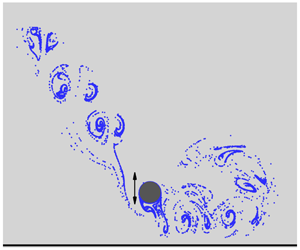Article contents
Flow induced by an oscillating circular cylinder close to a plane boundary in quiescent fluid
Published online by Cambridge University Press: 15 June 2020
Abstract

Flow induced by an oscillating circular cylinder close to a plane boundary in quiescent fluid is simulated numerically by solving the two-dimensional Navier–Stokes equations. The aim of this study is to investigate the effects of the gap ratio between the cylinder and plane boundary ( $G$), the oscillation direction of the cylinder (
$G$), the oscillation direction of the cylinder ( $\unicode[STIX]{x1D6FD}$) and the Keulegan–Carpenter (
$\unicode[STIX]{x1D6FD}$) and the Keulegan–Carpenter ( $KC$) number on the flow at a low Reynolds number of 150. Simulations are conducted for
$KC$) number on the flow at a low Reynolds number of 150. Simulations are conducted for  $G=0.1$, 0.5, 1, 1.5, 2 and 4, and
$G=0.1$, 0.5, 1, 1.5, 2 and 4, and  $KC$ numbers between 2 and 12. Streaklines generated by releasing massless particles near the cylinder surface and contours of vorticity are used to observe the behaviour of the flow around the cylinder. The vortex shedding process from the cylinder is found to be very similar to that of a cylinder without a plane boundary except for
$KC$ numbers between 2 and 12. Streaklines generated by releasing massless particles near the cylinder surface and contours of vorticity are used to observe the behaviour of the flow around the cylinder. The vortex shedding process from the cylinder is found to be very similar to that of a cylinder without a plane boundary except for  $G=0.1$ and
$G=0.1$ and  $\unicode[STIX]{x1D6FD}=0^{\circ }$, where vortices cannot be generated below the cylinder. Two streakline streets exist for all the flow regimes if there was not a plane boundary. A streakline street from the cylinder can be affected by the plane boundary in three ways: (1) it is suppressed by the plane boundary and stops propagating; (2) it rolls up after it meets the boundary and forms a recirculation zone; and (3) it splits into two streakline streets and forms two recirculation zones after it attacks the plane boundary. A refined classification method for flow induced by an oscillating cylinder close to a plane boundary is proposed by including a variant number, which represents the behaviour of the streaklines, into the regime names, and all the identified flow regimes are mapped on the
$\unicode[STIX]{x1D6FD}=0^{\circ }$, where vortices cannot be generated below the cylinder. Two streakline streets exist for all the flow regimes if there was not a plane boundary. A streakline street from the cylinder can be affected by the plane boundary in three ways: (1) it is suppressed by the plane boundary and stops propagating; (2) it rolls up after it meets the boundary and forms a recirculation zone; and (3) it splits into two streakline streets and forms two recirculation zones after it attacks the plane boundary. A refined classification method for flow induced by an oscillating cylinder close to a plane boundary is proposed by including a variant number, which represents the behaviour of the streaklines, into the regime names, and all the identified flow regimes are mapped on the  $KC$–
$KC$– $G$ plane. The drag and inertia coefficients of the Morison equation are obtained using the least-squares method. A very small gap of
$G$ plane. The drag and inertia coefficients of the Morison equation are obtained using the least-squares method. A very small gap of  $G=0.1$ significantly increases both the drag and inertia coefficients especially when
$G=0.1$ significantly increases both the drag and inertia coefficients especially when  $\unicode[STIX]{x1D6FD}=0^{\circ }$. If
$\unicode[STIX]{x1D6FD}=0^{\circ }$. If  $G=1$ and above, the plane boundary changes the drag coefficient by less than 10 % compared with that of a cylinder without a plane boundary, and the effect of the plane boundary on the inertia coefficient is weak only when the
$G=1$ and above, the plane boundary changes the drag coefficient by less than 10 % compared with that of a cylinder without a plane boundary, and the effect of the plane boundary on the inertia coefficient is weak only when the  $KC$ number is sufficiently small and vortex shedding does not exist.
$KC$ number is sufficiently small and vortex shedding does not exist.
JFM classification
- Type
- JFM Papers
- Information
- Copyright
- © The Author(s), 2020. Published by Cambridge University Press
References
- 7
- Cited by


